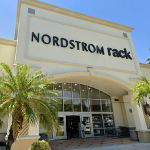JD Sports’ U.S. segment, including The Finish Line and its initial JD Sports locations in the U.S., saw sharp gains in profits on strong sales in the first half. The improvement was attributed to a “temporary government stimulus driving a material, but temporary, impact on performance.”
Sales across locations in the U.S. rose 13.8 percent to £825.5 million from £725.2 million a year ago. Profit before tax doubled to £73.4 million from £35.7 million a year ago.
JD acquired The Finish Line in 2018. At the end of the six months ended August 1, the U.S. business included 495 Finish Line stand-alone locations, 295 Finish Line in-store shops inside Macy’s and 17 JD Sports locations. The company began the year with 508 Finish Line stand-alone locations, 295 Macy’s shops and 11 JD locations in the U.S.
JD Sports said in a statement on the U.S. business, “Consistent with comments from other national retailers in the United States, our businesses benefitted significantly from May onwards from the fiscal stimulus made available by the US Government. Total revenues across physical and digital channels increased by nearly 50 percent in this period with gross margins also at elevated levels in this period as many consumers took advantage of their extra spending power and traded up to full price new styles. This stimulus program ended at the end of July and, to date, there is no agreement for it to be renewed.
“The outbreak of COVID-19 has not changed our overall view on the strategic development of JD and Finish Line across the United States and it remains our intention to increase the critical mass of JD in the major metropolitan areas through a combination of opening new stores and converting Finish Line stores where appropriate. Six stores were converted in the period in the ‘badge flip’ style and it is our current intention to convert up to 30 more stores in the second half with one conversion completed already. The exact number of conversions in the rest of the year will, however, ultimately depend on the extent of any new restrictions in each location. Elsewhere, works continue on our new flagship store in Times Square, New York, with this store scheduled to open in October although the current situation means that the initial footfall into this store will be at lower than expected levels.”
Companywide, JD reported sales decreased 6.5 percent in the first half to £2,544.9 million from £2,721.2 million a year ago. Sports Fashion reduced by 4.6 percent to £2,402.4 million. Outdoor reduced by 30.2 percent to £142.5 million.
Given the impact of COVID-19 on the performance in the period, presenting revenues in like for like terms is not appropriate.
Total gross margin in the period across the Group of 45.6 percent was 1.3 percent lower than the prior year. This primarily reflects the promotional activity in stores in the UK and Europe after re-opening to clear non-seasonally relevant products.
Profit before tax and exceptional items decreased 61.0 percent to £61.9 million. Within this, the profit before tax and exceptional items of the Group’s businesses in the United States has increased significantly to £73.4 million from £35.7 million a year ago, reflecting the positive impact of the temporary Government stimulus in the country.
On a Pro-forma basis under IAS 17 ‘Leases’, with rents recognized according to contractual terms, the headline profit before tax and exceptional items to August 1, 2020 for the Group would have been £10.9 million higher at £72.8 million, albeit down 56.2 percent from £166.2 million a year ago.
There were exceptional items in the period of £20.4 million against £28.7 million a year ago, with both largely related to Go Outdoors that is undergoing a restructuring.
Group profit before tax ultimately fell 68.1 percent to £41.5 million from £129.9 million a year ago.
Peter Cowgill, Executive Chairman, said:
“Throughout the COVID-19 pandemic, our priorities have been to ensure the safety of our colleagues and customers, to preserve financial resources and limit the impact on profitability. Continuing outbreaks of the virus and periodic strengthening of public safety measures in a number of our global territories, including forced temporary store closures and the ongoing requirement to maintain strict social distancing in our warehouses, makes us cognizant that further challenges lie ahead.
“Ultimately, given the unique circumstances of this trading period, we are reassured by the strength of the JD brand as demonstrated by the retention of more than 90 percent of the total revenues. However, it should be recognized that this has necessitated additional costs principally relating to the provision of enhanced health and safety measures, in all areas of the business, together with increased costs of online fulfillment, including performance marketing. Whilst these additional costs have impacted on the result for the period, the Group has retained a significant level of profitability with a profit before tax and exceptional items of £61.9 million (2019: £158.6 million).
“We are generally encouraged by our performance since the stores re-opened and with our performance in the first few weeks of the second half. However, retail footfall remains comparatively weak and the recent strengthening of measures in many countries and the subsequent temporary closure of some stores reminds us that COVID-19 remains an ongoing challenge. Nonetheless, we remain absolutely confident in our strengths in consumer engagement, key brand relationships and globally consistent multichannel retail standards. These, combined with an agile operational infrastructure, provide us with a robust platform for further positive development.
“We also believe that it is appropriate for the Group to reinstate guidance for the full year. Assuming a prudent but realistic set of assumptions for the peak trading period that reflect an uncertain outlook for consumer confidence, the ongoing challenges of attracting footfall to stores and the potential for further operational restrictions; we would presently anticipate delivering a headline profit before tax for the full year of at least £265 million when calculated under IFRS 16 ‘Leases’.”















